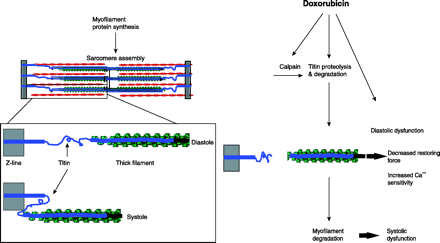
- Institution: Stanford Univ Med Ctr Lane Med Lib/Periodical Dept/Rm L109
- Sign In as Member / Individual
The Cardiotoxicology of Anthracycline Chemotherapeutics: TRANSLATING MOLECULAR MECHANISM INTO PREVENTATIVE MEDICINE

Mechanistic role of titin and anthracycline-induced cardiotoxicity. Myofilament damage is a key element in anthracycline-induced cardiotoxicity, which along with reduced myofilament protein synthesis contributes to the cardiac injury that begets heart failure. Specifically, treatment of myocytes with doxorubicin induces breakdown of the giant myofilament protein titin (185 kDa), ultimately leading to myofibrillar disarray and myocyte cell death. Titin normally spans the half sarcomere from M-line to Z-line and functions as a spring, storing the energy during systole and diastole that helps restore the cell to resting length (see inset). Hence, titin is essential to cardiac function, and its degradation alters myocyte contractile function in several ways that could contribute to the clinical syndrome of heart failure.


